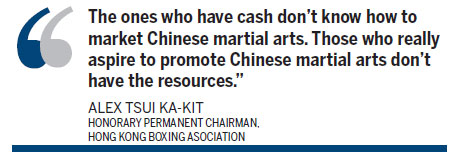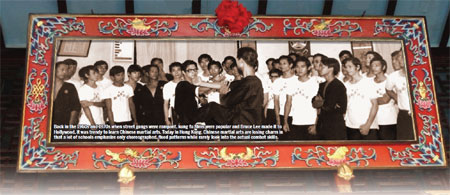Kung Phooey
By Andrea Deng ( HK Edition )
Updated: 2013-09-20
Forty years after the death of kung fu legend Bruce Lee, it's Marquis of Queensbury rules or Muay Thai for anyone into combat training in Hong Kong, while the art of kung fu Lee helped popularize fades into a limbo of form over substance. Andrea Deng writes.
Everybody was talking at once around the big table on the second floor of the two-story Cantonese restaurant in Yau Ma Tei: discussing the guest list for a banquet; all the big names would be there, the top ten kung fu masters in Hong Kong, like the bygone, glory days of the martial arts scene.
"If I am gonna call Yuen, I'm sure he will come." The speaker was Leung Ting, master of Wing Tsun, trained by Ip Man himself, the legendary teacher of Bruce Lee.
The man Leung was speaking about was world-renowned martial arts choreographer and film director Yuen Wo-ping.
"But we just don't have many seats," lamented Leung, who operates more than 3,000 Wing Tsun training centers worldwide. "Let's not bother him," he concluded.
Also seated at the table was Chu Shiu-ki, master of Choy Li Fut, and sifu of actor Donnie Yen Chi-tan, who portrayed Ip Man in three-biographical films about the grandmaster from Foshan.

There was action film maker Chang Kuen and the honorary permanent chairman of the Hong Kong Boxing Association, Alex Tsui Ka-kit, a well-known Muay Thai combatant.
Chu's son, Cheuk, sitting quietly beside his father, took a sip of Tieguanyin, then, lowering his voice, he said, "Kung fu is not my thing," extending his business card. His "thing", according to his business card, is distributing "high-tech" skin care products from the US in Hong Kong. But he grew up in Hong Kong, far from the world of anti-wrinkle pills, surrounded by dozens of "uncles" - kung fu practitioners from different schools of Chinese martial arts. He heard the tales of feuds and friendships among myriads of local masters, phonies, outright losers, and chauvinists after one school or other.
"The banquet about the ten Chinese martial arts masters ... what do you think other martial arts masters would think about this banquet? Who said they really are the top ten masters?" Cheuk asked.
The discussion around the table meandered to the grim state of martial arts in Hong Kong today. The tradition, everyone agreed, seems to have deteriorated into eternal bickering among those striving for reputations: who was more orthodox? Who was the true follower of the great kung fu masters?
It's all very complicated, observed Cheuk. Who's jealous? Who's just a braggart? Who's vying to build a reputation while exaggerating his skills? Around it goes, "in the circle". Nobody likes to say much, name names. Kung fu today is mostly form without substance. People into serious combat training turn to Muay Thai or Western boxing. But really, people aren't into fighting any more.

"Brats in the old days, in the 60s or 70s, felt obliged to learn Chinese martial arts because bullying was common. There were street gangs. Besides, they grew up watching kung fu movies. Kung fu was the lifestyle. Today people watch variety shows, and movies about love," said Cheuk.
Kung fu movies are still around. They still have some following, though its getting smaller every year. Forty years after the death of Bruce Lee, the legends of kung fu have become diluted, and the gap between kung fu movies and reality seems pretty wide.
Choreography or combat
Bruce Lee's legend lives on, his popularity, undiminished all these decades since his short life ended at the age of 32. There's a book, published just recently, about Lee's hybrid kung fu style, Jeet Kune Do. It describes Lee's meticulous studies of attack and defense, as the system of combat that would make him a global icon took form. But the Chinese martial arts Lee made popular faded after he died, and today are considered more in the genre of artistic dance than of unarmed combat.
Nowadays, many schools of Chinese martial arts focus on teaching fixed patterns of punches, kicks, and blocks that look remarkably impressive but have only limited application to actual self-defense.
Some families engaged in martial arts for generations have shut down their schools, continuing only their practices in Chinese pharmacy, treatment of bone injuries and doing the lion dance.
"For many years Chinese martial arts have not been used for combat. They are just dancing in patterns, not for self-protection," said Wai Kee-shun, a veteran sports commentator, now a consultant for the Hong Kong Chinese Martial Arts and Lion Dance Association.
Leung Ting, the Wing Tsun master, agrees. "Traditionally some of the schools were very practical (for combat training). But they're mainly practicing patterns now," he said.
There is nothing wrong with practicing patterns as such. Forms are common in other combat sports, like Karate and Taekwondo, Leung said. Patterns used to be taught to standardize the forms used by the school, or to teach disciples to use the moves in combination before applying them in actual combat.
The problem is, Leung said, while many schools of Chinese martial arts have taken standardized patterns as a sign of "orthodoxy" to that school of kung fu - to build up reputation, they have gradually given up practicing instant, improvised responses in actual combat.
"I believe that the Chinese way of thinking embraces a fallacy that being orthodox is equal to being phenomenal," Leung remarked.
Both Wai and Leung were careful to refrain from commenting about other schools, for fear of offending other masters.
"It is fine to brag or exaggerate a little, but it is taboo to disparage others," said Leung.
"There is nothing wrong with that (practicing patterns without paying attention to practicality) and I'm sure there is still a huge market in China," Wai said. However, he added, "If you're satisfied with the current status quo, it is fine. But if you want to advance, you have to go out and compete with people."
The way out
Kung fu tournaments have been rare in recent decades. One reason, Leung said, was lack of sponsorship. Leung organized an invitational Chinese martial arts competition in 1982. Everyone remembers it, especially Leung, who lost more than HK$100,000 on the enterprise.
"At that time, a house cost just HK$80,000. We (Chinese martial arts practitioners) are just good at practicing kung fu, but not so much as businessman," Leung sighed and laughed. He organized another competition in 2005, losing less money - but learning the lesson not to bother organizing another competition in future.
"Hong Kong people are not interested in Chinese martial arts," Leung admitted.
While Chinese martial arts can be practiced for physical health, the lack of genuineness and practicality of today's Chinese martial arts has reduced much of its old time charm. As some said, today's Chinese martial arts lack a good "brand image".
Staged competition is the key for every combat sport, and so it should be for Chinese martial arts, said Alex Tsui. Tsui dabbled in various combat sports since he was 16, ancient Muay Thai, Aikido, Sanshou, Western boxing and so forth.
"Not that arena fighting reflects everything about the sport, but it is a platform to showcase the practicality and excitement of the sport. People will be attracted and the sport will be injected with much greater vitality," Tsui remarked.
"Chinese martial arts are special because they were used for combat. That is how Wing Tsun or Choy Li Fut became famous," he said.
"There are negative sides to arena fights. They are dangerous, bloody, and they uphold the make-or-break, all-or-nothing philosophy. But it doesn't lie. Genuineness is priceless," Tsui added.
Tsui believes Chinese martial arts must be commercialized and branded - like any other fan sport - to regain public interest. "A market can be made. And we're not just talking about the China market. We're talking about a global market," he said.
Not all martial arts practitioners agree, Leung noted. Not every school of Chinese martial arts favors combat. Some maintain a low-profile and pursue a strict philosophy "to fight only when necessary".
Nonetheless, it seems a universal goal that almost all Chinese martial arts practitioners want to change the current situation.
"Those who want to learn Chinese martial arts don't know which sifu they should look for. And when the public watch real martial arts on YouTube, they feel disappointed," said Leung.
"The ones who have cash don't know how to market Chinese martial arts. Those who really aspire to promote Chinese martial arts don't have the resources," said Tsui.
"Chinese martial arts are a treasure. But the government fails to do anything (to promote them), while a lot of private parties only eye their own benefits, thus there is no concerted effort (to promote the sport) and there is not any sort of standard - phonies and braggarts are common and they are killing Chinese martial arts," said Tsui.
Contact the writer at andrea@chinadailyhk.com
|
Back in the 1960s and 1970s when street gangs were rampant, kung fu films were popular and Bruce Lee made it to Hollywood, it was trendy to learn Chinese martial arts. Today in Hong Kong, Chinese martial arts are losing charm in that a lot of schools emphasize only choreographed, fixed patterns while rarely look into the actual combat skills. |




